Top 15 Organic Produce That's Better Than Conventional

For many years now, there have been many debates over
whether buying
organic is better for you than conventional foods. Organic certainly sounds better. It
might be just a buzzword of the day for some people, another way to feel
superior over non-recycling gas guzzlers, but does it actually make a difference
to the quality of the food? Many people say yes ó but to be honest, many of them
are the same people who try to convince their friends that yes, granola does
taste better than candy bars if you just find the right granola.
Of course, there are some merits to buying organic over conventional. Apart from the
much-touted environmental impact of many pesticides, there are a whole bunch of
reasons to buy organic ó that is, to buy certain foods organic. While the impact
on the earth may be substantial for things like organic wheat and organic cat
food, many people are much more concerned with the effect that pesticides (from
conventional produce) have
on their internal systems as well as those of their families. Yes, there are
good reasons to buy certain foods organic, and those foods generally tend to be
whole fruits and vegetables.
By soaking up all of the precipitation and surrounding pesticides left over
from killing crop-damaging bugs, many whole conventional fruits and vegetables are
susceptible to picking up something else as well ó a lot of pesticides that
arenít entirely safe to eat. The foods on this list are the ones that are the
most important to buy organic.
15) Organic Kale
Alright. Chances are that if youíre thinking about buying organic, youíre
already eating more kale than the average person. For everyone out there
gleefully cramming handfuls of non-organic kale into their mouths, it may be
time to stop (for at least a few reasons).
Kale is very healthy, but it's not a great food to buy off the non-organic rack. All the fantastic
antioxidants and vitamins that make it such a staple of a healthy cupboard
arenít too great when stacked up against the possibility of pesticides. These
veggies tend to soak up a lot of pesticides, given the average water intake and
how fast it gets flushed to the capillaries of each weird knobbly leaf.
Fresh Organic Kale
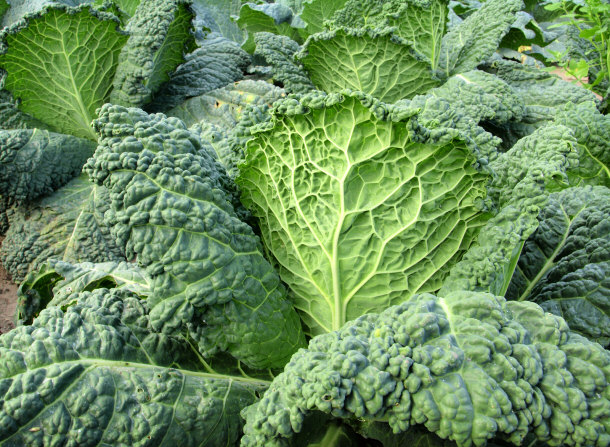
If you happen upon a bunch of organic kale at a farmerís market or a large
supermarket, you may be a bit stumped if youíre not familiar with how to work
with it. There are many kinds of kale, from regular leafy dark green kale to the
far more visually intriguing ďdinosaur kale,Ē as well as the somewhat-aptly
named rainbow kale (which is pretty much just green and purple). There are a lot
of ways people eat kale, some more delicious than others. One way to best
preserve the nutrients in this leafy green is to wash thoroughly (even if youíve
bought it organic), chop it into smallish pieces, and steam it for between 10-15
minutes. It will have a rougher texture than a lot of greens and a deep, nutty
taste.
Another way to eat kale for the less nutritiously-inclined is in kale chips.
Rip the kale into bite-sized pieces, toss with olive oil and salt, and bake at
400 degrees for 15 minutes. It might not be a replacement for potato chips, but
it will make even a health nut admit that chips can taste good.
Organic Kale Chips
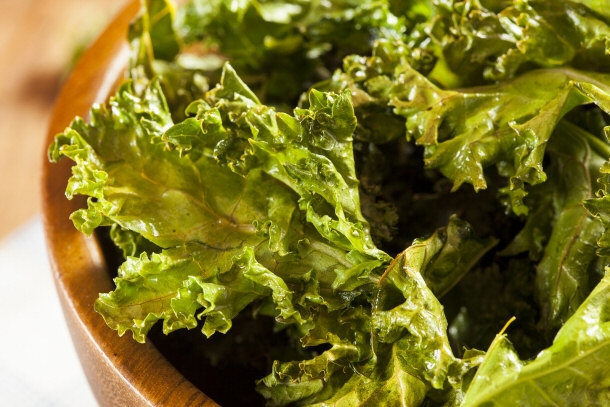
14) Organic Collard
Greens
No, this entire list will not be about leafy green vegetables. All conventional
leafy greens, however, are definitely susceptible to being contaminated with
pesticides because of the amount of water they soak up. Thatís one of the
reasons leafy greens are so healthy; theyíre essentially just water, healthy
chlorophyll, fiber, and other nutrients. If
youíve ever heard myths about foods you can eat that take more calories to chew
and digest than they give you through digestion, leafy greens are probably the
closest you can come to a real-life example. The amount of nutrition packed into
them, in Vitamin A, Vitamin B and Vitamin C is a huge incentive, not to mention
how crammed full they are of essential minerals like iron.
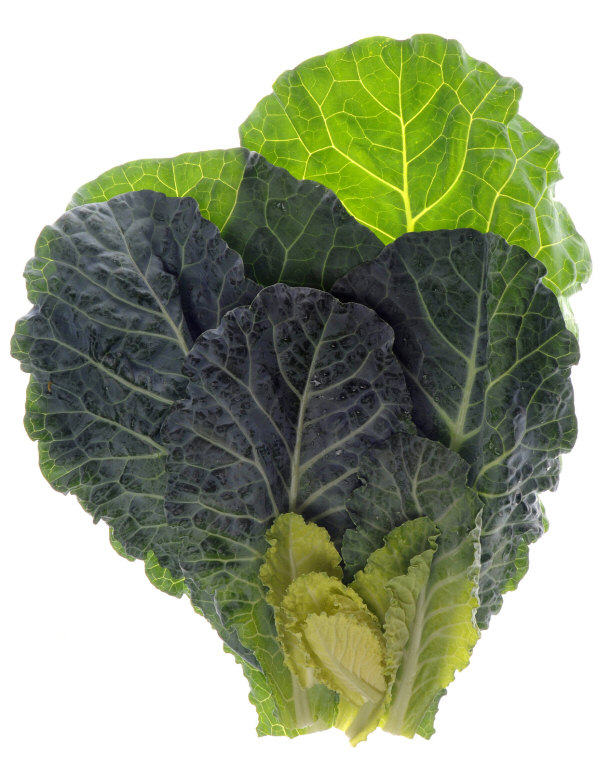
Unfortunately, collard greens are generally popular and eaten in the south.
If you live in the south, youíre probably well aware that itís not the most
organic-friendly place to shop. If youíre lucky, youíll be able to hit up a
local farmerís market a few times this summer. If not, just make sure you wash
your collard greens very thoroughly and very carefully before chopping them up
and serving them. You could be washing away quite a lot of pesticides that have
hidden in the little nooks, crannies and capillaries of the greens. Washing
wonít completely do away with pesticides but itís a decently good start on the
path to a healthier pantry.
13) Organic
American-Grown Summer Squash
For once, the thing to beware is the sign ďgrown in America.Ē Imported summer
squash is usually not grown with pesticides and domestically-sourced summer
squash is usually pumped full of the stuff. If youíre not totally familiar with
summer squash, itís zucchini and the little yellow squashes that kind of taste
and feel like zucchini but (probably) arenít. Sometimes they come in weird
shapes and colors, and have odd little names like ďpatapan,Ē which doesnít sound
like something most people would want to eat.
Fresh assorted Summer Squash
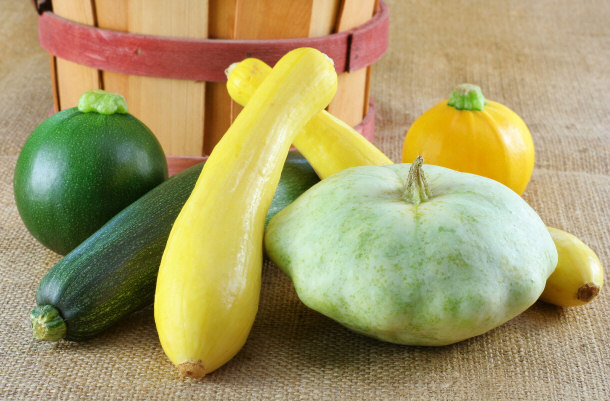
The good news is that when summer squash are in season, theyíre pretty much
everywhere. Every organic farmerís market offers bushels of them for low prices,
for the easy reason that theyíre incredibly simple to grow in a large variety of
soil. Try them chopped up and sautťed with a splash of soy sauce as a great
accompaniment to fish or steak on a summer evening. Alternatively, try slicing
or peeling them very thin and serving them as if they were a healthy sort of
pasta. It sounds strange, but with enough cheese and marinara, you wonít even
miss the carbs.
Squash shredded and cooked like pasta

12) Organic Hot
Peppers
Hot peppers arenít the kind of fruits or vegetables that most people would think
of first when it comes to foods that should be purchased organically. One of the
reasons for that is that most people who cook with them (in non-Mexican dishes)
use them so sparingly that itís difficult to see why they should bother buying
organic peppers.
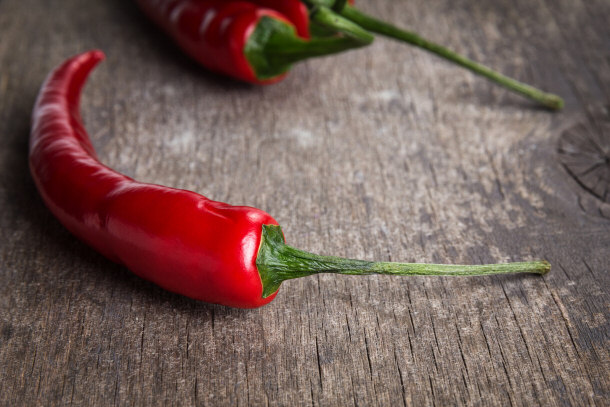
However, conventional peppers are one of the biggest risks for pesticide contamination.
Theyíre frequently imported in such large quantities that it can be difficult to
know for sure whether a pepper is organic or not, so make sure to check the
supermarket-assigned sticker.
If youíre going to use hot peppers to cook Mexican food, itís very important
that you make the effort to buy them from an organic grocer or at least from the
organic section of the grocery store. The skin of a pepper is so thin that it
makes it easy for the pesticides in soil to leak up through the porous skin and
then saturate the softer membranes of the pepper itself. Seeds are not exempt,
and in non-organic peppers, can be one of the most concentrated sources of
pesticides.
11) Organic Cherry
Tomatoes
Bad news, salad fans: conventional cherry tomatoes love sucking up all the pesticides they
can get from the soil in which they grow. These little bite-size jewels are so
good at sucking up the pesticides that itís highly recommended to only eat them
when you can find them organically. While this might be easy to do in late
summer when the bumper crop comes in, itís more difficult to do during the
winter or in a restaurant where theyíre served as a garnish to almost
everything.
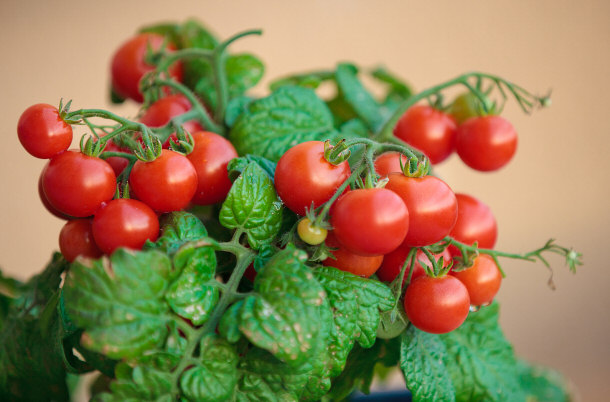
Surprisingly enough, regular-sized conventional tomatoes arenít at too much of a risk for
soaking up lots of pesticides. The thicker stem makes it easier for them to
filter out too many pesticides before they soak into the membranes, and a
thicker skin means that they arenít absorbing as many pesticides from contact
with the earth itself.
Someone has probably told you that itís very easy to grow a tomato plant in
your window or yard with no gardening experience. Knowing how easy it is to bite
down on a ripe hunk of pesticides when you buy cherry tomatoes from the store,
you might even want to look into getting a hanging planter. At least then youíll
know exactly what went into the little guys. As an added bonus: youíll never
find fresher produce than the one thatís hanging in your window.
10) Organic Potatoes
Potatoes are very different from most root vegetables. Thatís good, because you
probably wouldnít want to walk into your favorite burger joint and order a
quarter-pounder and parsnip fries. However, some of the things that make
potatoes different from other root vegetables are things that put them at
a much higher risk for pesticide contamination than their rooty brethren.
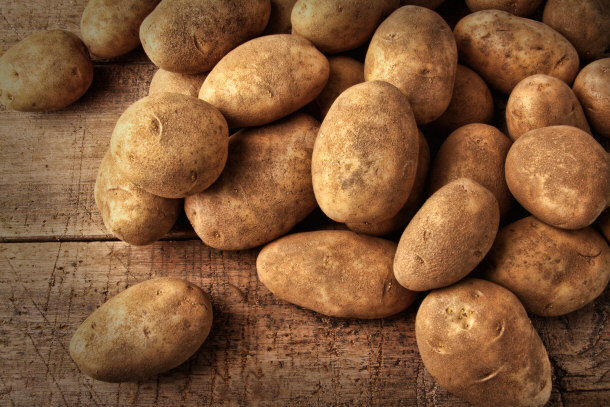
For one thing, while potatoes grow in the ground, theyíre chock full of
water. As usual, the fruits and vegetables that soak up the most water are the
most likely to soak up a lot of pesticides along with it. For another thing,
potatoes have a surprisingly thin skin compared to many other root vegetables.
Compare a potatoís skin with the skin of a beet, a rutabaga or even a yam. By
contrast, the skin of a potato is so thin that a vigorous scrubbing with a
sponge can rub it right off (using russet potatoes as an example). That thin
skin means itís more porous, and more of the nutrients ó and pesticides ó in the
dirt can seep in.
Try buying your potatoes organic. Theyíre such an inexpensive staple food
that it takes little effort to convert this purchase, and it can be a huge boost
to your health to avoid ingesting all that contaminated fiber and starch from
the conventional variety.
9) Organic Cucumbers
Cucumbers are sort of ubiquitous. Itís hard to imagine salads, sandwiches or
even sushi without the cool crunch of a cucumber. However, these moisture-laden
veggies are at a very high risk for being contaminated with pesticides. Donít be
fooled by how thick the skin of a cucumber seems to be in the supermarket.
Shockingly enough, almost every major chain supermarket buys their cucumbers
encased in a thin layer of wax and other products before being shipped. Thatís
because the skin of a cucumber is actually so delicate that itís almost
impossible to ship and display them without bruising or damaging the delicate
skin.

Not only are these methods kind of gross (the wax doesnít come off with a
simple rinse), but theyíre also bad news for any vegan or vegetarian who has a
hankering for cucumbers. Yes, the outer coating of a cucumber may not only
contain wax ó those ďother productsĒ mentioned can include shellac (made from
the excretions of the lac beetle) and milk casein. Itís not vegan, not organic,
and certainly not appetizing to think about. If you canít get to an organic
section, peel conventional cucumbers before eating them if you donít want to be exposed
to all of that.
8) Organic Imported
Nectarines
This one is a stark contrast to the problem with domestic summer squash. In
America, pesticides arenít used so heavily on nectarines, because we donít have
nearly as many bugs that tend to try and eat the trees on which they grow.
Imported conventional nectarines, however, are susceptible to another host of bugs and
parasites. In order to combat them, farmers in other countries (primarily Mexico
and countries in South America, such as Chile) routinely spray their nectarine
trees with pesticides in order to kill the bugs. This can result in a loss of up
to 30 percent of the entire crop due to problems with pesticides, but many are
harvested on the borderline of acceptable and not acceptable. This is another
fantastic reason to buy your nectarines organic, or at the very least, domestic.
Not everyone can have a fruit stand in the back yard, but almost everyone can
access the organic section of a major supermarket.
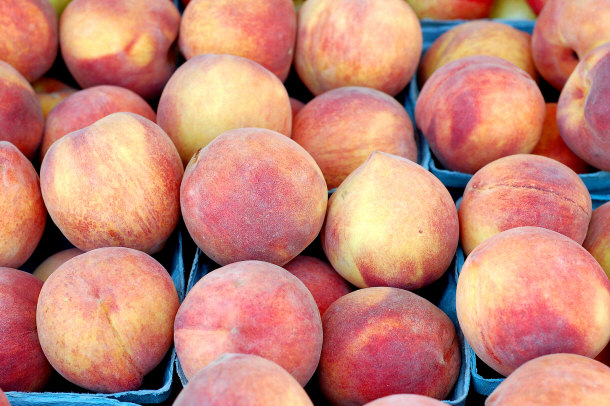
If youíve only ever had nectarines whole and raw, try baking them sliced into
a cobbler or pie. It sounds a little odd, but theyíre very close in nature to
peaches. For a chewier, more fibrous experience, leave the skins on. For a much
softer mouthful, peel the nectarines before cooking them.
7) Organic Sweet
Bell Peppers
You already know from this list that hot peppers are much better to buy organic,
when at all possible. However, sweet bell peppers are even more important to buy
organic when you have the opportunity. For one thing, many more sweet bell
peppers are consumed in the U.S., and in a much larger quantity per capita.
Secondly, unlike hot peppers, sweet bell peppers are frequently eaten raw. The
conventional green, red and yellow kinds are unfortunately all at risk for high pesticide
contamination and itís best to buy them organically.
Raw organic bell peppers
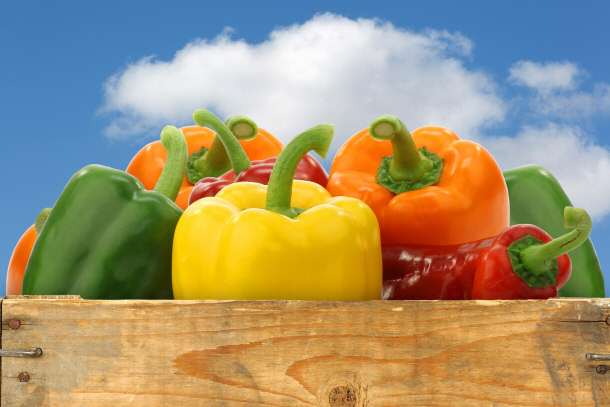
If youíre sick of eating peppers raw, try stuffing them full of your favorite
pasta filling and baking them. Ricotta cheese, mushrooms, and spices make a
fantastic filling for just about anything, and sweet bell peppers are no
exception. These peppers also hold up very well to being grilled alongside
chicken or steak at your next cookout. One method for doing this is to simply
lay the pepper on the open flame until itís somewhat charred, then flip it over.
The skin of the pepper protects it from being harmed by the actual flame and the
inside achieves a fantastic caramelization. Another option for grilling is to
make a hunk of sweet bell pepper part of a skewer with meat and other
vegetables.
Organic bell peppers grilled in kebabs with chicken

6) Organic Spinach
The most popular of all the leafy greens, besides lettuce, is also the most
susceptible to pesticide contamination. Spinach has some of the thinnest, most
delicate leaves among all vegetables, which puts it at massive risk for
contamination by water carrying pesticides. The nature of spinach, and the fact
that it soaks up so much water into its delicate leaves contributes to the fact
that itís one of the most important vegetables to buy organic.
Fresh organic spinach in a garden
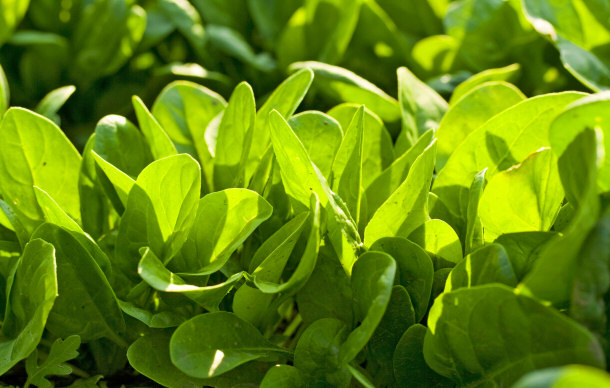
If your only thought of spinach is the stuff youíve seen Popeye chug out of a
can, think again. The boiled and chopped spinach might be a staple of Sunday
dinner at your great-grandmotherís house, but this leafy green has been
reinvented by a new generation of foodies. Used in place of lettuce for salad,
baby spinach packs a huge punch of vitamins and minerals, and has an intriguing
texture that isnít too different from other leafy greens as to make it seem
weird. The taste is another selling point; even kids that wonít touch a lettuce
salad might eat a salad made out of baby spinach, as long as they arenít told
what it really is. Or, try mixing it up with tuna fish for a classic salad
nicoise to impress guests at a dinner party. The dark look and fresh taste makes
it an intriguing blend to use with fruit salads, so try pairing it with
strawberries for a fun summer salad.
Organic spinach, strawberry and walnut salad
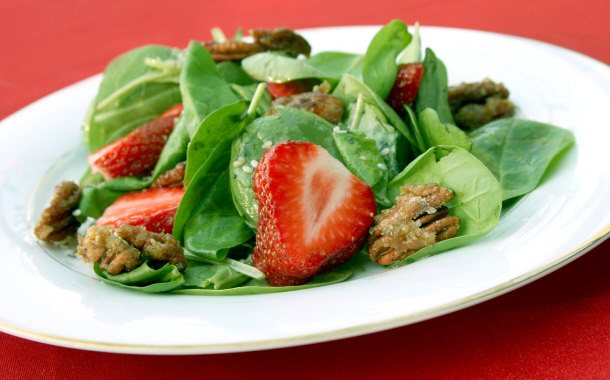
5) Organic Peaches
Peaches are one of the more popular fruits in America, and for good reason. Not
only are they commonly grown locally, theyíre sweet and just the slightest bit
tangy, as well as being a staple of many classic American recipes, such as peach
cobbler and peach pie. These fruits arenít quite as hardy as their cousins, the
nectarines, however. The skin of a peach, that infamous fuzzy covering, is
incredibly soft and porous. Unlike cucumbers, the skin is so delicate and the
texture is so unique that it cannot be covered by wax in order to transport.
Massive amounts of peaches are lost every year due to excessive bruising in
transit, so itís understandable that farmers want to keep as many of them viable
as possible by spraying for bugs and other contaminants.

Unfortunately, thatís the reason that peaches are some of the worst fruits
and vegetables to buy in a non-organic section. The porous skin that is so
famous and easy to pull off becomes way more of a liability than a benefit when
it comes to soaking up pesticides. If you can possibly afford and manage to buy
your peaches organic, do so. Itís one of the most important foods that you can
buy organic, and with good reason. Especially if your household consumes a lot
of peaches yearly, thatís a lot of pesticides that can add up if you go the
conventional route.
4) Organic Celery
Is there a food with a higher water content than celery? Well, yes. Watermelon
contains over 90 percent water, but the point is celery contains a great deal of
water. Itís also commonly served to children as one of the mildest-tasting
vegetables ó who can forget eating ďants on a log,Ē raisins on peanut butter on
a stick of celery? Itís great for dipping, great for snacking, and great for an
on-the-go lifestyle. As one of those foods that takes more energy to digest than
you consume calorically by eating it, itís also a traditionally great choice for
dieters.

Unfortunately, all that water content means water constantly cycling through
the celery stalk all through the growing process. The more water is cycled
during that process, the more chance there is of contamination by pesticides.
Conventional celery is one of the worst foods you can eat without buying it organically;
making it even worse is the fact that itís consumed in such mass quantities
throughout America. If youíre not buying your celery organically, you could be
dieting and snacking your way to a pesticide-filled belly. Make the effort to
buy at least your celery organically since itís the vegetable with the highest
chance of contaminating your family with pesticides.
3) Organic Grapes
Grapes have such a high water content that itís possible to freeze them ó and a
good idea, as well. If you have frozen grapes sitting around, you can use them
in place of ice cubes to keep from watering down your drinks at parties. Grapes
are also one of the great fruits to be used as snack foods and one of the least
likely foods to be cooked. After all, whoever heard of a grape pie?

Unfortunately, one effect of eating grapes raw is that thereís no chance for
pesticides to be neutralized in the cooking process. Grapes are so often
consumed raw that the pesticides go right into the mouths and bodies of those
eating them, and the high water content means that theyíre been sucking up water
filled with pesticides from the ground for as long as theyíve been growing.
Fortunately, most supermarkets do carry organic grapes, if they carry organic
anything. Theyíre a bit more expensive than the conventional kind, as everything
is, but this food is so high in potential pesticides that itís very important to
make the leap.
2) Organic
Strawberries
You know a fruit is popular when itís the most popular flavoring on the market
as well. Strawberry popsicles, strawberry gummy chews, strawberry hard candy --
strawberry everything is as popular as the flavor of summer itself. Even though
quality in-season strawberries are only available for a short time, the impact
they have on flavor profiles is stunning. Wild strawberries are some of the most
exciting finds a kid can make, and theyíre nutritious enough that any family
would feel good about serving these sweets.

However, strawberries contain 92 percent water. Not only that, but the skin
of a strawberry is extremely thin and porous, letting lots of water and other
contaminants in with ease. Conventional strawberries are one of the foods most likely to be
affected by pesticides in the entire catalog of fruits and vegetables, and can
pose a serious danger if you find yourself something of a strawberry addict.
Organic strawberries are usually widely available, but sometimes only for the
summer months, depending on where you live. If you canít find organic
strawberries, think very carefully whether the risk of ingesting all those
chemicals is worth the experience of biting into a juicy, ripe, ruby-red berry.
1) Organic Apples
An apple a day may keep the doctor away ó and the dentist, given how good eating
raw apples is for your teeth ó but it can also give you another daily dose: your
daily dose of pesticides and chemicals. Apples are so ubiquitous in so many
varieties and flavors that itís sometimes hard to think of them all as one
species; after all, a soft Golden Delicious is about as different from a tart
crisp Granny Smith as a strawberry is from a pear Ė in taste and in texture. Yet
no matter what kind of apple you buy, you stand a huge risk for being
contaminated with pesticides if you donít buy your apples all organically. A
traditional snack food, apples and apple slices are unfortunately very prone to
contamination. Even if you buy all of your own produce organically, it would be
a good idea to ask before consuming apples at restaurants or at someone elseís
party, just in case the apples youíre eating donít happen to be organic.
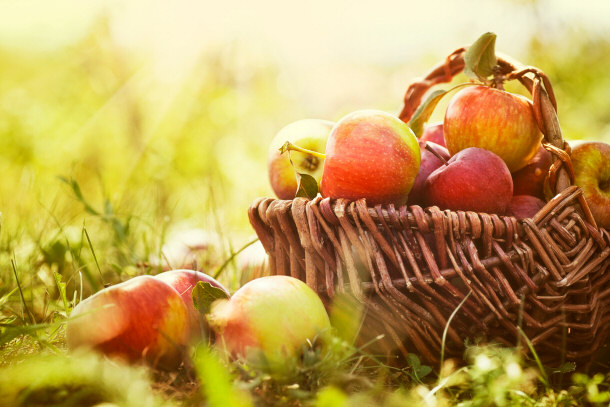
For an easy, healthy dessert, core an apple, stuff with your choice of nuts,
sugar or even nothing at all, fill a shallow pan with water, and bake the apple
in the pan for 40 minutes. This sweet treat will have you thrilled knowing you have
safe, organic produce.
Organic apple baked with nuts and honey
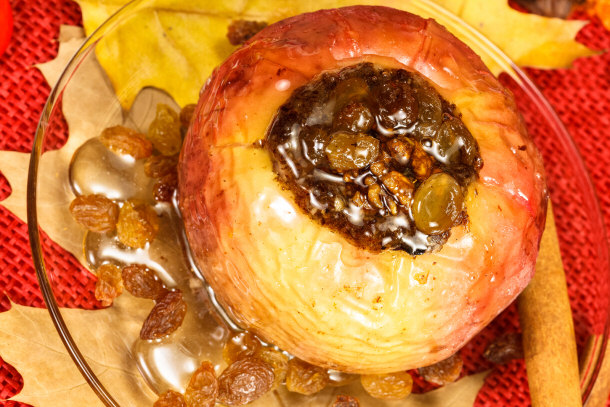
Conclusion
Produce can be a tricky thing to know how to purchase. After all, there are a
thousand choices between the regular conventional foods section, the local foods section, the
organic foods section, the exotic foods section, and many more besides. Some
stores donít even label their produce that well (although if the fruit or
vegetable has a Ď9í in the front of the PLU code, the food is organic). It can
be very difficult to know whether itís even important to
buy organic. Hopefully,
when you know more about
which foods are the most important to buy organic,
youíll be able to make a more informed choice about the health of yourself and
your family.
Diet & Nutrition
Top Lists:
Top 15 Foods That Help Migraines
24 Food Additives That You Should Consider Avoiding
Top 15 Healthy Spices From India
15 Disgusting Ingredients In Your Food
15 Best Foods For Brain Health
15 Foods That Are Surprisingly Good for You
Top 15 Organic Produce That's Better Than Conventional
15 Weird Interesting Facts About Vegetables
10 Best Cleansing & Detoxifying Foods
Informational:
Evaluating Diet Plans: Which One is Right for You?
The Essential Health Benefits of Ginger
The Health Benefits of Kale
Top Natural Appetite Suppressants That Will Help You Lose Weight
Almond: The Magic Pill For Hunger, Weight Loss and Cholesterol
How Effective is Phen375 in Losing Fat?
What Are Health and Losing Weight Benefits of Unique Hoodia?
Organic Foods Ė Are they better than Conventional Foods?
Facts about Alcohol
Best Ways to Get a Good Nightís Sleep
General Benefits of Green Tea
Health Benefits of Inositol Supplements
Anti-Aging Foods to Stay Young
Who is Responsible For Overweight Children?
My Secret to Losing 100 Pounds in 6 Months
How and When to Use HCA Extract? |